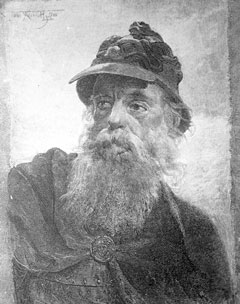Siege of Pemaquid (1689) facts for kids
Quick facts for kids Siege of Pemaquid (1689) |
|||||||
|---|---|---|---|---|---|---|---|
| Part of King William's War | |||||||
 Baron Jean-Vincent d'Abbadie de Saint-Castin |
|||||||
|
|||||||
| Belligerents | |||||||
| Acadia Abenaki |
New England | ||||||
| Commanders and leaders | |||||||
| St. Castin and Father Louis-Pierre Thury Chief Moxus |
Lieutenant James Weems | ||||||
| Strength | |||||||
| 100 to 300 | 18 to 30 | ||||||
| Casualties and losses | |||||||
| unknown | Possibly a total of 80 from both sides. | ||||||
The Siege of Pemaquid was an important battle that happened on August 2–3, 1689. It was a successful attack by a large group of Abenaki Native Americans on an English fort. This fort, called Fort Charles, was located in Pemaquid, which was then part of colonial Massachusetts.
The attack was led by Jean-Vincent d'Abbadie de Saint-Castin, a French leader, along with Father Louis-Pierre Thury and Chief Moxus. The fall of Pemaquid was a big problem for the English. It forced their border to move back to Casco (Falmouth), Maine.
Contents
What Was the Siege of Pemaquid?
The fort at Pemaquid was led by Lieutenant James Weems. The fort was not strong because many soldiers had left earlier that year. This happened after Governor Edmund Andros was removed from power in Boston.
Only about thirty soldiers were left at the fort, and many of them were unhappy. The Native American forces surrounded the fort. They captured or killed most of the people living in the area around the fort.
How Did the Battle Unfold?
Lieutenant Weems and his soldiers defended the fort for one day. But they suffered many injuries. Weems and 23 of his soldiers were wounded. Because of this, they decided to surrender.
The Abenaki allowed Weems and his men to go back to Boston. On August 4, the Abenaki burned down the fort. They also burned the nearby settlement of Jamestown.
What Happened After the Siege?
After the attack, Massachusetts sent 600 soldiers to the border area. Major Jeremiah Swaine led these soldiers. They met on August 28, 1689, and searched the region.
The Native Americans killed 10 of Swaine's men at Falmouth. Even with Swaine's soldiers nearby, the Native Americans attacked Oyster River (Durham, New Hampshire). They killed 21 people and took several others captive. Major Swaine was then replaced by Major Benjamin Church.
The Story of John Gyles
One of the people captured by the Maliseet was John Gyles. He was taken to their main village, Meductic, on the Saint John River. John Gyles later wrote about his time as a captive. This story is one of the few captivity narratives from Nova Scotia or Acadia.
John's brother, Thomas, managed to escape the siege. Sadly, John's third brother, James, was also captured by the Penobscot at the same time. James was taken to Fort Pentagouet (now Castine, Maine). There, he was tortured and killed.
Rebuilding and Another Attack
The fort at Pemaquid was rebuilt with stone in 1692–93. It was renamed Fort William Henry. However, four years later, d'Abbadie de Saint-Castin and the Wabanaki Confederacy captured it again.


